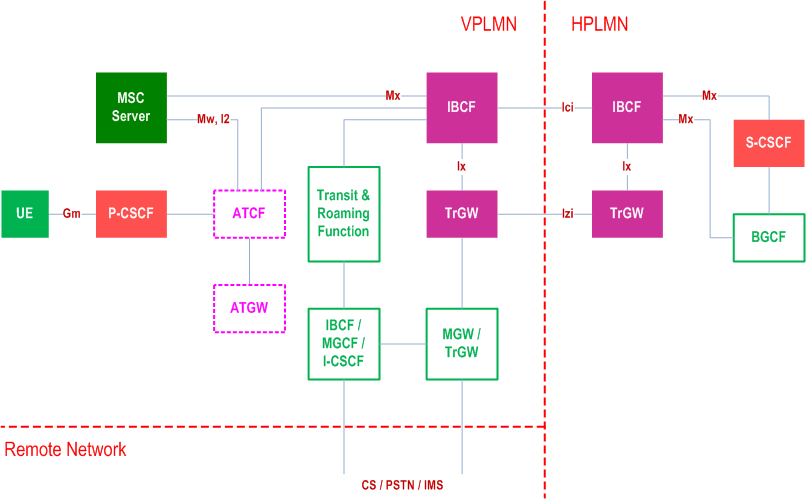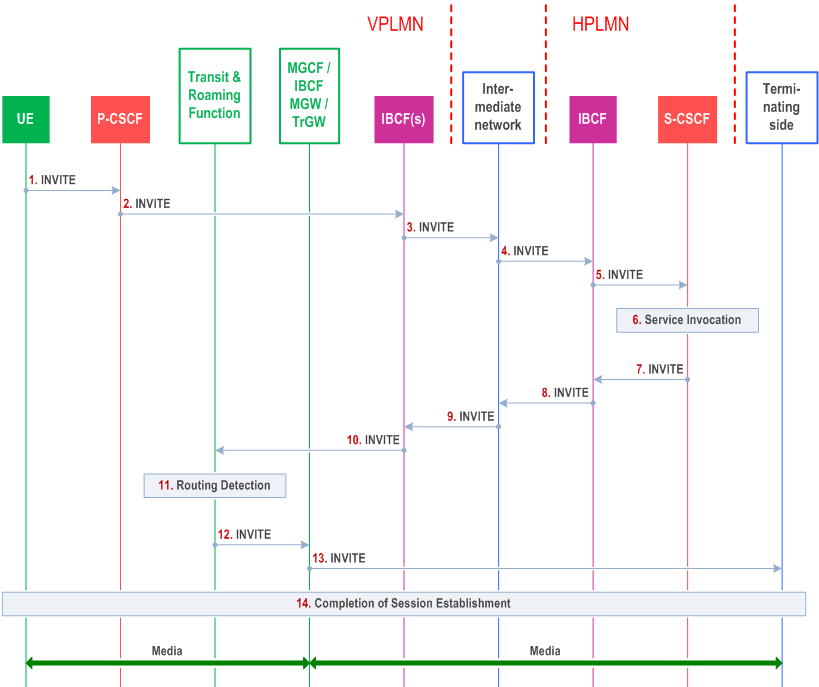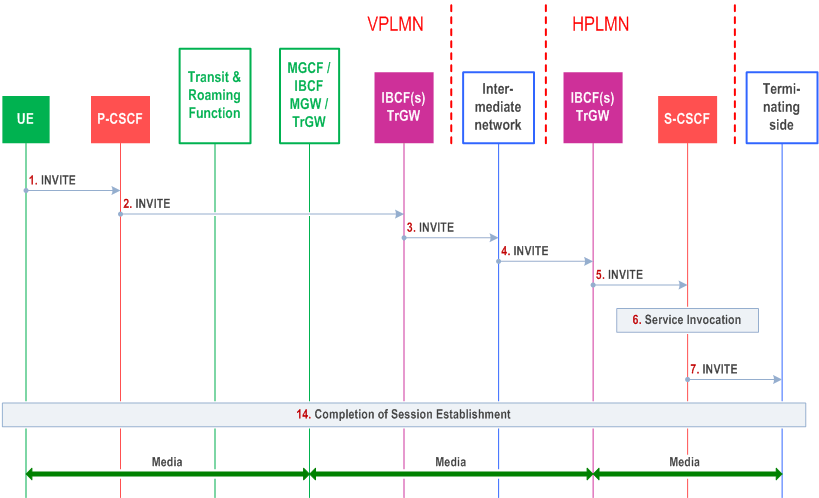Content for TS 23.228 Word version: 18.6.0
1…
3…
4…
4.2.4…
4.3…
4.4…
4.13…
4.16…
5…
5.2…
5.3…
5.4…
5.4.7…
5.4.8…
5.4a…
5.5…
5.5.3…
5.6…
5.6.3…
5.7…
5.7.3…
5.7.5…
5.7.8…
5.8…
5.10…
5.11…
5.11.3…
5.11.3.3
5.11.3.4
5.11.4…
5.11.5…
5.11.5.3…
5.11.6…
5.12…
5.16…
5.16.2…
5.19…
5.20…
A…
E…
E.2.2…
G…
G.5…
H
I…
J…
K…
L…
M…
M.3…
N…
P…
Q…
Q.2.5…
R…
S…
T…
U…
U.2…
V…
W…
X…
Y…
Z…
AA…
AA.3…
AB…
AC…
AC.7…
AC.7.2…
AC.7.2.2
AC.7.2.3…
AC.7.4…
AC.9…
M.3 P-CSCF located in visited network and with VPLMN loopback possibility
M.3.1 Description
M.3.1.1 General
M.3.1.2 Architecture
M.3.1.3 Flow for originating session with VPLMN routing
M.3.1.4 Flow for originating session with Home routing
M.3.2 Interaction with SRVCC and ICS
...
...
M.3 P-CSCF located in visited network and with VPLMN loopback possibility |R11| p. 268
M.3.1 Description p. 268
M.3.1.1 General p. 268
The architecture and flows in this clause are assuming local breakout with P-CSCF in VPLMN, for further info about local breakout see clause M.1.
M.3.1.2 Architecture p. 268
The architecture for this scenario is shown in Figure M.3.1.2. The Transit and Roaming Function and the related requirements are defined in clause 4.15a.

M.3.1.3 Flow for originating session with VPLMN routing p. 269
The information flows for originating session with VPLMN routing for this scenario is illustrated in Figure M.3.1.3.

Step 1.
The roaming UE sends an INVITE request to the P-CSCF.
Step 2.
P-CSCF forwards the INVITE request to the visited IBCF. Based on operator policy, the P-CSCF adds a reference to the preferred Transit and Roaming Function.
Step 3.
This first IBCF in the VPLMN allocates a TrGW for the media and follows standard OMR procedures when forwarding the INVITE request to allow this TrGW to be bypassed if the INVITE request later returns to the VPLMN and no other intermediate nodes anchor the media before the request returns.
Step 4-5.
The intermediate network and the first IBCF in the HPLMN forward the INVITE request to the S-CSCF. Nodes in the intermediate network and the first IBCF in the HPLMN support OMR and allow their TrGWs to be bypassed.
Step 6.
The S-CSCF performs service invocation.
Step 7.
The S-CSCF performs routing decision, and based on local policy and on the facts that the UE is roaming, a roaming agreement for VPLNM call routing is in place, and home routing is not required, the S-CSCF decides to route back to the VPLMN for call routing. A loopback indicator is included in the INVITE request to inform the VPLMN that this request is being routed back to the VPLMN for call routing. The S-CSCF can also forward UE location information to the VPLMN. If a reference to the preferred Transit and Roaming Function is available in the request, the S-CSCF uses this information to route the session back to the VPLMN. If a reference to the preferred Transit and Roaming Function is not available, the S-CSCF uses a default derived address to the Transit and Roaming Function to route the session back to the VPLMN.
If local policy requires access to BGCF routing data to make the loopback decision for a particular SIP request, then the loopback decision can be performed in the BGCF.
Step 8-9.
The IBCF in the HPLMN and the intermediate network forward the SIP request towards the indicated Transit and Roaming Function in the VPLMN. Functions in the intermediate network support OMR and allow their TrGWs (if any) to be bypassed.
Step 10.
The IBCF in the VPLMN receives the SIP request, notes that the SDP includes an alternative media address within the VPLMN that allows bypass of allocated TrGWs, applies OMR to remove any TrGWs allocated between the VPLMN and HPLMN, and forwards the request to the indicated Transit and Roaming Function.
Step 11.
Based on the loopback indicator, the Transit and Roaming Function detects that this is a loopback request. The Transit and Roaming Function routes the request toward the destination network based on available SIP URI, ENUM lookup, or BGCF routing. The Transit and Roaming Function can use information such as originating UE location to select a nearby egress point for media anchoring.
Step 12.
If the called party is determined to be available in IMS, the call is routed towards the remote end through an IBCF. If the called party is determined to be available in CS, the call is broken out to CS through an MGCF. If the called party is determined to be available in VPLMN, the call is routed to the I-CSCF. The called party information is included in the Request-URI when forwarding the request to the next hop.
When forwarding to an IBCF, the Transit and Roaming Function ensures by means of signalling that media is anchored in the VPLMN.
Step 13.
The MGCF/IBCF performs normal call routing procedures to route towards the remote network/end.
Step 14.
The session establishment is completed.
M.3.1.4 Flow for originating session with Home routing p. 270
The information flows for originating session with the possibility for VPLMN routing, but where the HPLMN decides to perform home routing is illustrated in Figure M.3.1.4.

Step 1-6.
These steps are done according to clause M.3.1.3.
Step 7.
The S-CSCF performs routing decision, and based on the facts that the UE is roaming, and home routing is required, the S-CSCF decides to route the INVITE request directly from the home network towards the terminating side. If local policy requires access to BGCF routing data to make the routing decision for a particular SIP request, then the routing decision can be performed in the BGCF. When forwarding, the S-CSCF/BGCF ensures by means of signalling that media is anchored in the HPLMN.
Step 8.
The session establishment is completed.
M.3.2 Interaction with SRVCC and ICS p. 271
The IMS roaming with local breakout and possibility for loopback also applies for ICS and SRVCC as follows:
- For an originating session for PS to CS SRVCC or vSRVCC that uses ATCF enhancements, the ATCF is in the signalling path between the P-CSCF and IBCF in the VPLMN (i.e. at step 2 in clause M.3.1.3).
- For an originating sessions that uses CS media with MSC Server enhanced for ICS, the UE initiates a CS call setup towards the MSC Server enhanced for ICS, and the MSC Server enhanced for ICS will initiate the call setup towards IMS analogous to the INVITE request from P-CSCF (i.e. at step 2 in clause M.3.1.3). As for the P-CSCF, the MSC Server enhanced for ICS may provide a reference to the preferred Transit and Roaming Function: